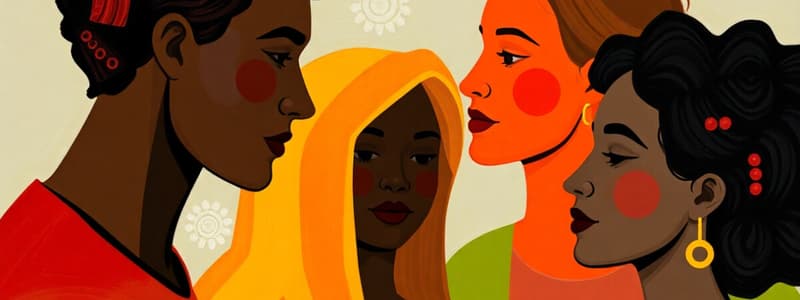Podcast
Questions and Answers
A counselor is working with a client who identifies strongly with their cultural heritage. How should the counselor primarily interpret the client's presentation?
A counselor is working with a client who identifies strongly with their cultural heritage. How should the counselor primarily interpret the client's presentation?
- By understanding the norms and values within the client's specific cultural context. (correct)
- By consulting with other professionals who have worked with clients from similar backgrounds.
- By comparing the client's behaviors to the norms of the majority culture.
- By relying on their own research about the client's culture.
A counselor is unsure how to proceed with a client from a different cultural background. What would be the MOST appropriate first step?
A counselor is unsure how to proceed with a client from a different cultural background. What would be the MOST appropriate first step?
- Focus solely on the client's individual experiences, disregarding cultural factors.
- Consult with a supervisor or colleague knowledgeable about the client's culture. (correct)
- Immediately refer the client to a counselor of the same cultural background.
- Rely on generalized information about the client's culture to guide the session.
A client from a collectivist culture is struggling to make an individual career decision that conflicts with their family's expectations. What approach would be MOST suitable for the counselor?
A client from a collectivist culture is struggling to make an individual career decision that conflicts with their family's expectations. What approach would be MOST suitable for the counselor?
- Encourage the client to prioritize their individual needs above their family's wishes.
- Focus solely on the client's career goals, avoiding discussion of family dynamics.
- Advise the client to follow their family's expectations to maintain cultural harmony.
- Facilitate a discussion between the client and their family to explore shared values and find a mutually agreeable solution. (correct)
A counselor notices that a client consistently avoids discussing certain aspects of their cultural background. What should the counselor do FIRST?
A counselor notices that a client consistently avoids discussing certain aspects of their cultural background. What should the counselor do FIRST?
Which of the following counseling approaches demonstrates cultural humility?
Which of the following counseling approaches demonstrates cultural humility?
A counselor is working with a client who is experiencing microaggressions in the workplace. What would be an appropriate initial intervention?
A counselor is working with a client who is experiencing microaggressions in the workplace. What would be an appropriate initial intervention?
In a counseling session, a client uses a metaphor rooted in their cultural background that the counselor doesn't understand. What is the MOST appropriate response for the counselor?
In a counseling session, a client uses a metaphor rooted in their cultural background that the counselor doesn't understand. What is the MOST appropriate response for the counselor?
What is the PRIMARY goal of advocacy in counseling?
What is the PRIMARY goal of advocacy in counseling?
A client is facing discrimination due to their sexual orientation. Which action best represents advocacy at the social/political advocacy level?
A client is facing discrimination due to their sexual orientation. Which action best represents advocacy at the social/political advocacy level?
A counselor believes that all people should be treated the same, regardless of their background, and approaches each client in the same way. Which of the following terms BEST describes this perspective?
A counselor believes that all people should be treated the same, regardless of their background, and approaches each client in the same way. Which of the following terms BEST describes this perspective?
Flashcards
What are examples of cultures?
What are examples of cultures?
Ethnicity, gender, sexual identity, and spirituality shape a person's social and cultural background.
Advocacy and Power
Advocacy and Power
Professional counselors assume there is a power differential among U.S. individuals when engaging in advocacy efforts.
Counselor Techniques
Counselor Techniques
The counselor uses metaphors to deepen the level of understanding shared with a client.
Cultural Interpretation
Cultural Interpretation
Signup and view all the flashcards
Biculturalism Definition
Biculturalism Definition
Signup and view all the flashcards
Multicultural Competency
Multicultural Competency
Signup and view all the flashcards
Cultural Diversity
Cultural Diversity
Signup and view all the flashcards
What is acculturation?
What is acculturation?
Signup and view all the flashcards
What is universal culture?
What is universal culture?
Signup and view all the flashcards
What does privilege mean?
What does privilege mean?
Signup and view all the flashcards
Study Notes
- Ethnicity, gender, sexual identity, and spirituality are instances of cultures.
- Professional counselors involved in advocacy should recognize the existence of a power differential among U.S. individuals.
- Counselors can deepen shared understanding with clients by employing metaphors.
- Professional counselors need to understand that the client's presentation should be interpreted based on norms from within the client's culture.
- Biculturalism is an aspect of the integration model of acculturation.
- Developing multicultural counseling competency requires a systems approach.
- When interacting with culturally diverse clients, it is important to remember there are more within-group differences than between-group differences.
- Acculturation refers to changes in behavior, cognitions, values, language, cultural activities, personal relational styles, and beliefs as a cultural minority group encounters the dominant culture.
- Universal culture refers to commonalities shared by all cultures and humankind.
- The intrapersonal and interpersonal process in which individuals engage to build a clearer and more complex cultural identity is known as cultural identity development.
- An etic perspective emphasizes universal qualities across cultures and counseling, whereas an emic perspective views each client as an individual, evaluated using their cultural norms.
- Privilege refers to the often unconscious and unearned power, access to resources, advantage, and social position based on cultural group memberships.
- Prejudice refers to prematurely holding a belief or attitude without appropriate examination or consideration of actual data, while discrimination refers to covert and overt behaviors based on generalizations about individuals' cultural group memberships.
- In the marginalization model of acculturation, individuals reject the values and customs of both their own culture and the host culture.
- Helping a client identify external social, political, economic, and cultural factors is an example from the ACA Advocacy Competency domain of Client/Student Empowerment.
- Referring a client denied an apartment lease due to race to a free legal clinic shows Client/Student Advocacy from the ACA Advocacy Competency domain.
- Oppression by force involves imposing an unwanted object, label, role, experience, or living condition on an individual or group, causing physical and psychological pain.
- Structural violence occurs when social, political, economic, and other institutional entities intentionally or unintentionally place barriers on development, wellness, dignity, and human potential.
- Self-awareness, client services, and community collaboration are key to the three-tier model of social advocacy.
- Hold our convictions with humility.
Studying That Suits You
Use AI to generate personalized quizzes and flashcards to suit your learning preferences.
Related Documents
Description
Explore multicultural counseling concepts like ethnicity, gender identity, and acculturation. Understand power dynamics and cultural norms in counseling. Professional counselors need to understand the importance of cultural differences. Learn about biculturalism and multicultural competence.




